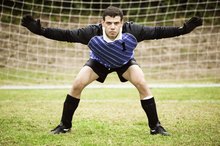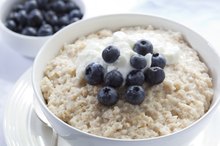What Food Does a Linebacker Need to Strengthen Up & Endure Speed?
A linebacker is a defensive position in American football. Linebackers line up behind the defensive linemen and are responsible for covering both the running game and the passing game. As such, linebackers need enough speed to cover receivers, but also enough strength and weight to tackle running backs and fight through the blocks of big offensive linemen. Linebackers need to eat protein-rich foods to build muscle, but they must also work out appropriately.
Muscle Building
Muscle building involves challenging muscle fibers with enough resistance until they slightly tear, at which point your body is stimulated to repair the fibers and make them bigger in diameter. Larger muscle fibers are stronger and able to contract with more force 13. In order to repair muscle fiber, your body needs an ample supply of amino acids from dietary protein. Scientific studies indicate athletes should consume between 0.5 and 0.8 grams of protein per pound of body weight on days they work out in order to build muscle most efficiently and increase strength. Furthermore, there is a about a two-hour window of opportunity post-workout in which your body is in high need of amino acids to repair muscles. Without enough amino acids during this time frame, your muscles do not repair themselves adequately.
- Muscle building involves challenging muscle fibers with enough resistance until they slightly tear, at which point your body is stimulated to repair the fibers and make them bigger in diameter.
- Furthermore, there is a about a two-hour window of opportunity post-workout in which your body is in high need of amino acids to repair muscles.
Protein-Rich Food
Recommended Fiber Intake for Athletes
Learn More
Like all serious athletes, linebackers need to train hard and eat enough protein to repair and build their muscles. Protein comes from both animal and plant-based foods, although almost all plant sources are missing at least one essential amino acid. Complete protein sources, such as:
- beef
- poultry
- fish
- provide all eight essential amino acids
- which is necessary for muscle repair
Not many linebackers and other serious athletes are vegetarians because most vegetables are low in total protein or incomplete sources of it. The exceptions are soy products, quinoa, hempseed and amaranth. Skinless chicken breast is an excellent low-fat source of protein, but athletes need fat for energy and healthy cellular repair.
- Like all serious athletes, linebackers need to train hard and eat enough protein to repair and build their muscles.
- Complete protein sources, such as: * beef
* poultry
* fish
* provide all eight essential amino acids
* which is necessary for muscle repair Not many linebackers and other serious athletes are vegetarians because most vegetables are low in total protein or incomplete sources of it.
Timing of Food
Prior to playing football or working out, linebackers need a quick source of energy, which is best derived from carbohydrates. Carbohydrates are readily metabolized into glucose and include pasta, bread, fruits and vegetables. Your muscles burn glucose for immediate energy or store it as glycogen. Consequently, a linebacker’s breakfast or pre-game meal should consist of plenty of whole grain foods and fruit, whereas the post-game meal or snack should be rich in protein. Eggs and dairy products digest the quickest, whereas a steak can take three or more hours. As noted, protein is needed for muscle repair and is only used as a source of energy when your glycogen stores are depleted.
- Prior to playing football or working out, linebackers need a quick source of energy, which is best derived from carbohydrates.
Appropriate Workouts
Losing Weight With Competitive Gymnast Diets
Learn More
Not all muscle fibers are the same. Fast-twitch muscle fibers are able to contract with more force because they contain lots of creatine phosphate and glycogen, which makes them best tailored to explosive bursts of running and tackling. Linebackers rely more on their fast-twitch fibers than their slow-twitch fibers, which are tailored toward endurance. Fiber type ratios are genetically determined, although training techniques can enhance the performance of fast-twitch fibers 1. High-intensity workouts involving power and speed, such as squats, are especially tailored to promoting fast-twitch fiber growth. In other words, lifting heavier weights fewer times and with full range of motion is best for athletes who want explosive speed and power.
- Not all muscle fibers are the same.
- High-intensity workouts involving power and speed, such as squats, are especially tailored to promoting fast-twitch fiber growth.
Related Articles
References
- Exercise Physiology: Energy, Nutrition, and Human Performance; William D. McArdle et al.
- Encyclopedia of Human Nutrition; Benjamin Caballero et al.
- Human Physiology: An Integrated Approach; Dee Silverthorn and William Ober
- Zierath JR, Hawley JA. Skeletal muscle fiber type: influence on contractile and metabolic properties. PLoS Biol. 2004;2(10):e348. doi:10.1371/journal.pbio.0020348
- Clark M, Lucett S, Sutton BG. NASM Essentials of Personal Fitness Training 4th edition revised. Philadelphia: Wolters Kluwer Health/Lippincott Williams & Wilkins; 2014.
- Powers SK, Howley ET. Exercise Physiology: Theory and Application to Fitness and Performance. New York: McGraw-Hill Higher Education; 2012.
Writer Bio
Sirah Dubois is currently a PhD student in food science after having completed her master's degree in nutrition at the University of Alberta. She has worked in private practice as a dietitian in Edmonton, Canada and her nutrition-related articles have appeared in The Edmonton Journal newspaper.









